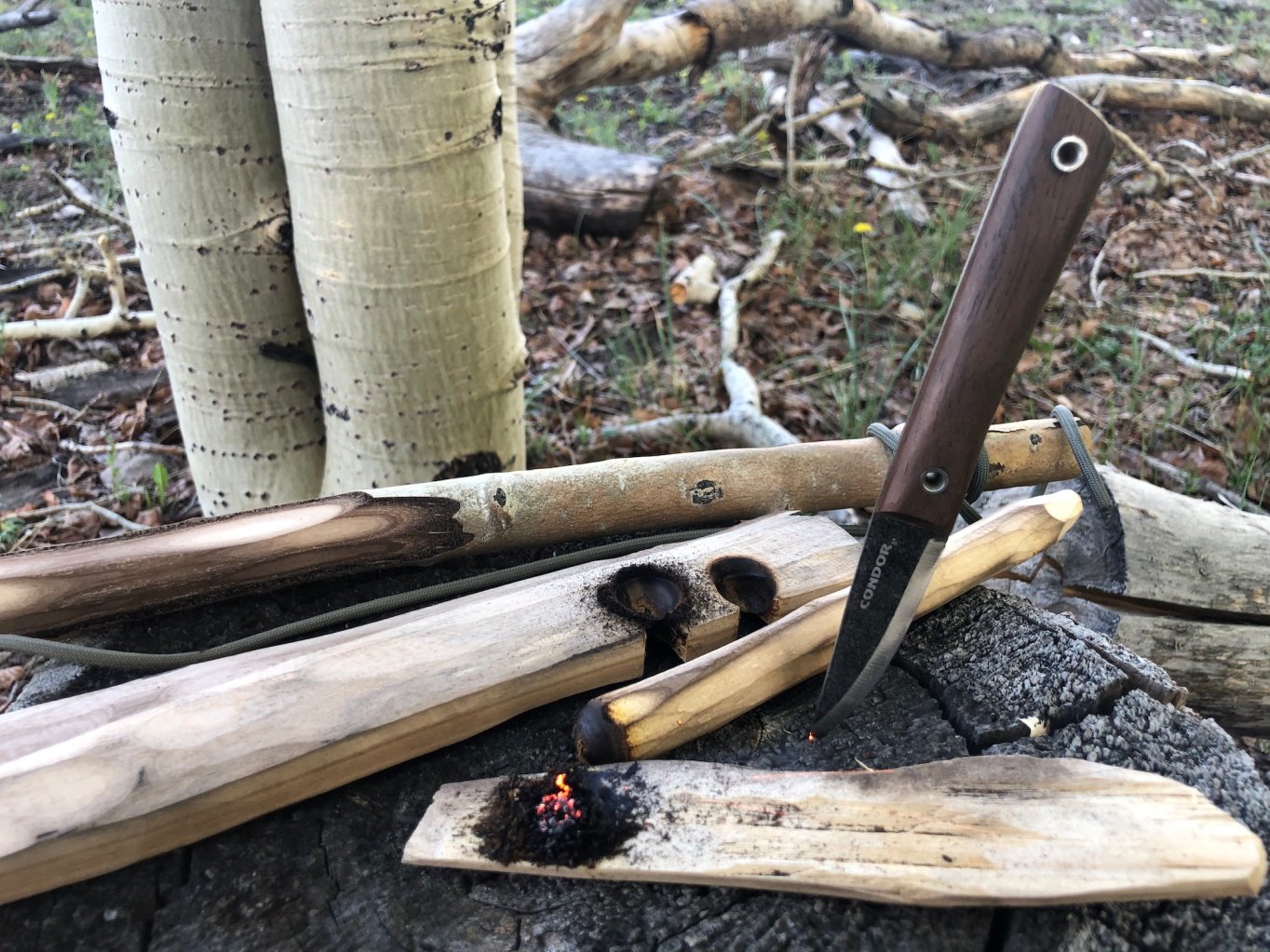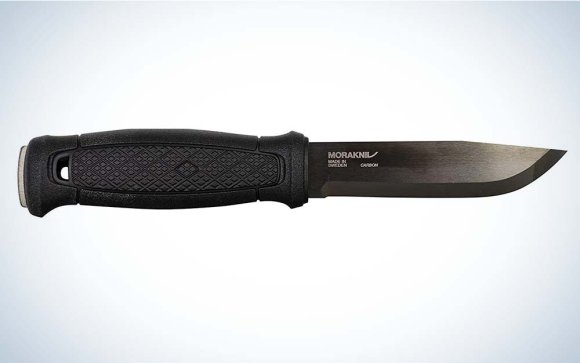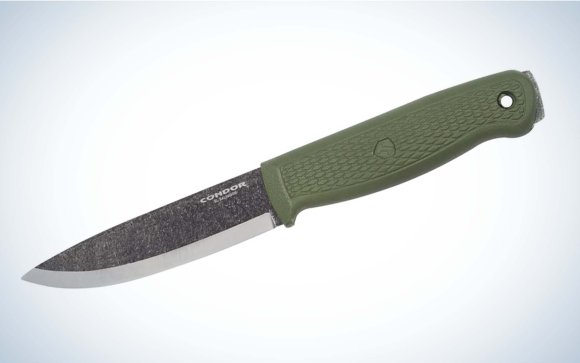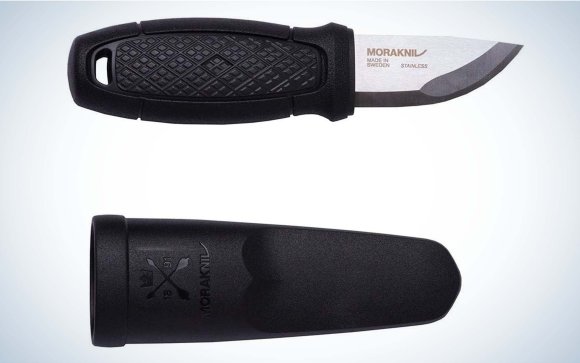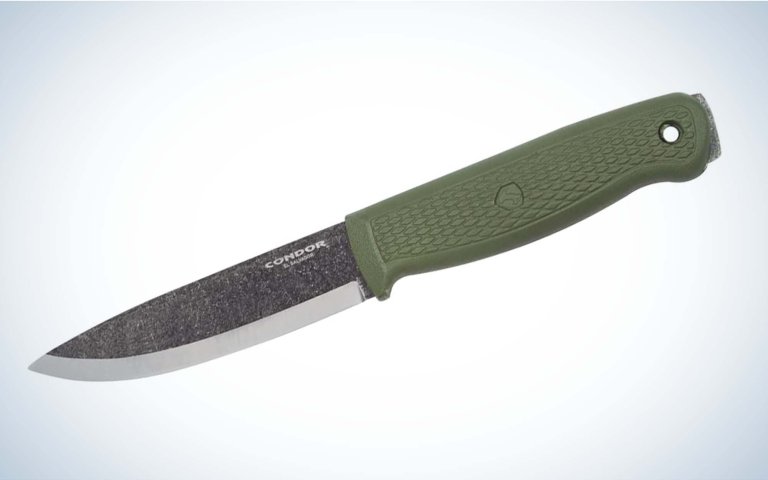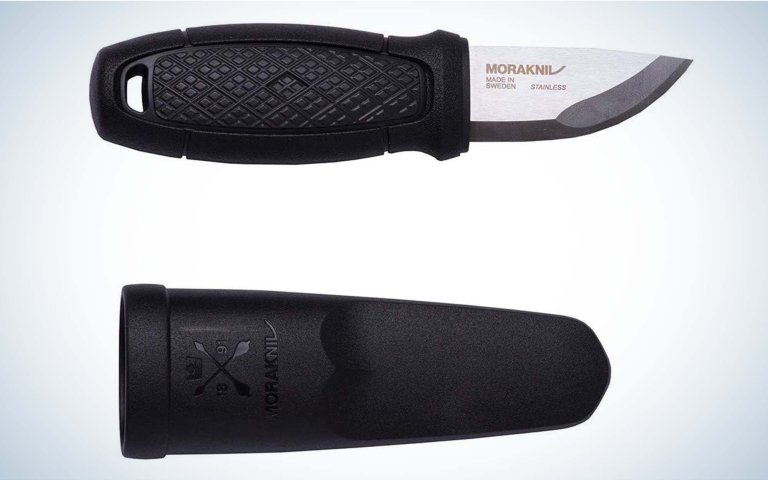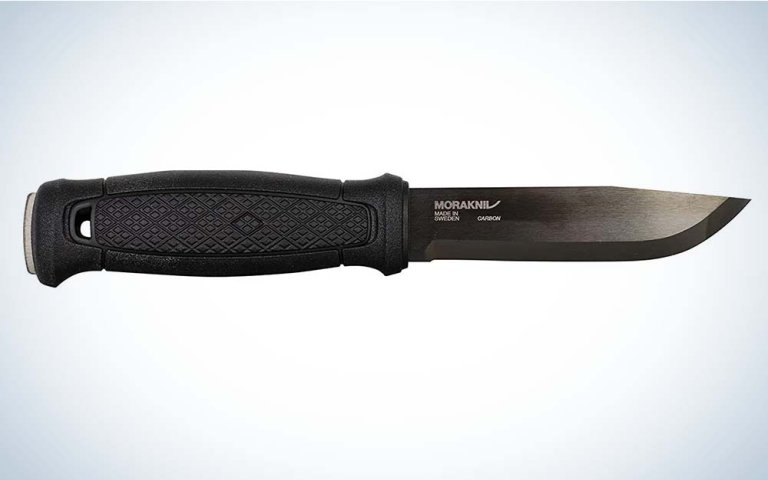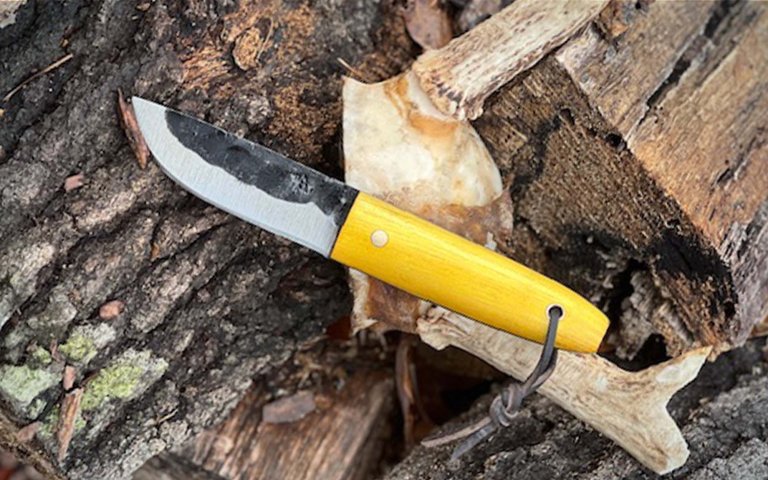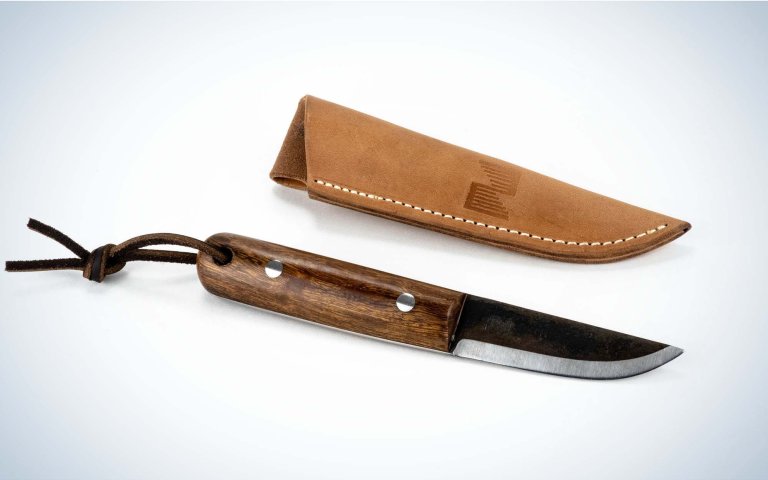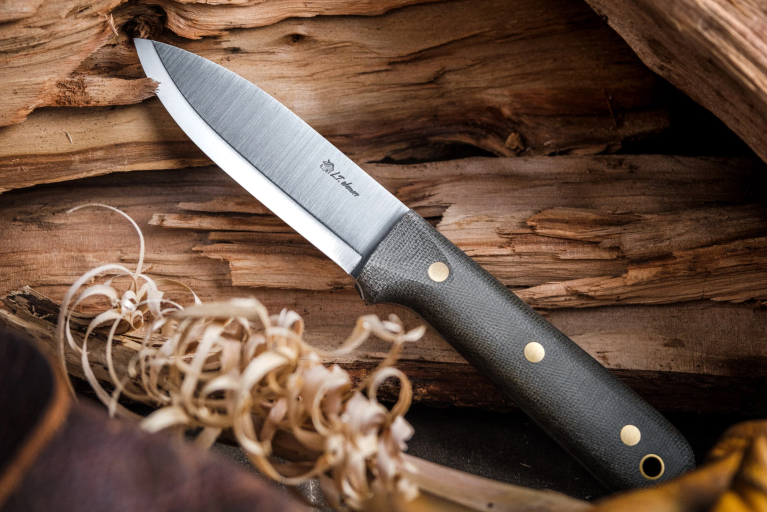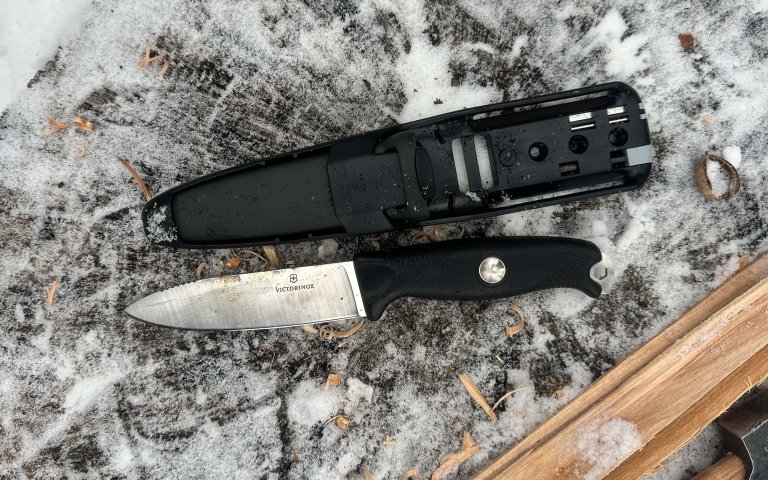We may earn revenue from the products available on this page and participate in affiliate programs. Learn More ›
I’m a survival instructor, so I’ve used and seen a lot of knives go through my courses. I’ve learned that a survival knife needs to be a jack of all trades. That’s why to test the following knives, I carved wood, sliced meat, broke bones, and cut rope. The blade isn’t the only business end of a good survival knife. So I also tested the knives’ spines for their ability to scrape fat wood and produce a spark from a fire steel.
There are more high-quality knives on the market today than ever before. From hand forged to super steels, there are so many options it can be overwhelming. The knives below are my selections based on my own personal experience in the field, combined with the testing criteria, value, and accessibility. There are many knives not mentioned here that are great blades as well, but these are the ones I have come to trust, and so can you.
These are my final choices for best survival knives:
- Best Value: Condor Terrasaur
- Best Compact: Morakniv Eldris
- Best Production: Morakniv Garberg
- Best Hand Forged: Hobo Forge Puukko
- Best for Versatility: Sacha Puukko
- Best Semi Custom: LT Wright Genesis Scandi
- Best for Fire Making: Victorinox Venture Pro
How I Tested The Best Survival Knives


Survival knives are your backcountry skeleton key. They are specialized at not specializing. They need to carve wood, process game, start a fire, and take on hard-use cutting. I tested a variety of survival knives with that in mind.
The Wood Carving Test
I conducted three carving tests to get a good sense of control, comfort, durability, and edge retention for wood carving projects.
Mors Kochanski Try Stick
This is a classic bushcraft skill test developed by the renowned Canadian bushcraft instructor Mors K. In this test, many techniques and cuts are tested on a single branch, and these mimic many different types of camp chores that are likely in a survival situation.
Feather Stick
The classic method of turning a branch into more combustible kindling is by shaving fine “feathers,” thereby increasing burnable surface area and exposing dry wood.
Batoning
Splitting by driving the knife through the wood parallel to the grain. This is achieved by striking the knife on the spine with a wood branch or “baton”. This tests the overall knife’s durability and allows larger pieces of wood to be processed much more quickly than carving down to the desired shape.
Rope Cuts
After the wood cutting tests, I cut paracord, nylon webbing, and climbing rope. To get a sense of how well the edges bite into the sheath of a rope after a lot of use.
Scoring
After each test, each knife was given a score of 1 (poor) to 5 (excellent) based on its performance and the following characteristics.
- Control
- Ergonomics
- Fine cuts
- Power cuts
- Edge durability
- Overall durability
The Game Processing Test
Any good survival knife should also perform reasonably well as a hunting knife capable of skinning, basic field dressing, and meat processing. While I couldn’t test each knife equally on these skills, I’ve carried several of these blades in the field with me and used them for processing whitetail deer, elk, and fish. Purpose-built hunting knives are typically thinner and have their edges ground differently than survival knives, which makes them more efficient for game processing. Unfortunately, this means the edges are often too fragile for the broad work of survival skills.
For each of these knives, I took my prior knowledge from the field combined with simple kitchen processing to score them from 1 to 5 on their ability to cut meat.
Spine Test

For this test, I used the knife’s spine to process kindling into tinder and throw a spark from a fire steel. This is a unique criteria for survival knives not often found in other types of blades. A good square spine with a burr edge can be a big advantage specific to lighting fire. Each knife was again rated from 1 to 5 on its ability to scrape wood and throw sparks.
Read Next: Best Ferro Rods
Best Survival Knives: Reviews & Recommendations
Best Budget: Condor Terrasaur
Pros
- Solid value
- Great reputation over it’s 10 years on the market
- Comfortable grip
- Good general-use size
Cons
- 1095 will need to be oiled and maintained
- Spine of knife needs a bit of work to function optimally
Key Features
- 1095 high carbon steel
- Polymer grip
- Full tang
- 4.2-inch blade
- 8.8-inches overall
- 0.118-inch thick
- Scandi grind
- Polypropylene sheath
- Price: $48
The Condor Terrasaur is a knife that packs a lot of value and features into a very reasonably priced package. It’s been around for over 10 years, and, for about $50, is a great option for a highly capable survival knife. You often don’t see full tang construction in knives at this price point, and the 1095 is a proven steel for survival applications. The profile of the Terrasaur is about as utilitarian as it gets with a drop-point, spear-shaped blade and lends itself well to a variety of camp chores and cutting tasks, including use as a hunting knife. The handle is a highly durable polymer that provides a stable grip in many positions.
For a general-use survival blade, a knife blade that is about as long as the width of the user’s hand is a good place to start, and this fits the bill for many folks. It allows for a lot of control at the tip but the blade is still long enough for batoning through a 2.5-inch branch to make a friction fire hearth board. Morakniv also has some really solid offerings well under the $50 price, however all the features of the Terrasaur get my vote for one of the best options for the money out there. Designed by Joe Flowers as a multi-use fixed blade, this would be a great knife to keep in a bugout pack, the truck, or anywhere you would want to have a reliable tool at an affordable price.
Best Compact: Morakniv Eldris
Pros
- Great for fire building
- Will fit anywhere
- Easy maintenance
- Very comfortable grip with great control
Cons
- Limited by the short blade
- Less durable so you must know it’s limitations
Key Features
- Recycled Swedish stainless steel
- Scandi grind with square spine
- 2.3-inch blade
- 6.02-inches overall
- 0.08-inch thick blade
- 2.82 ounces
- Polymer sheath
- Price: $28
I have to admit that I really appreciate small knives that can do big work, and the Eldris is a great example. The large swell in the handle makes it one of my favorite wood carving knives. It can be held in any position and used for hours and remain comfortable.
This is a great choice for backpackers or anyone traveling light. You can set the knife up in many ways, but I prefer to wear it as a neck knife under a jacket. It keeps it accessible and doesn’t interfere with a backpack the way a belt sheath can. There is also an optional retention strap for the molded sheath to increase security, but I haven’t found it to be necessary on mine.
The square spine on the Eldris is ready to go out of the package, and it throws great sparks and will easily process tinder. It’s simple to maintain and easy to sharpen. The blade will cut meat well as it’s a bit thinner but is limited by its length. It makes an outstanding second knife to compliment a larger cutting tool. It’s available as just the knife with a sheath or as a fire-starting kit. I’ve been using one for years, and starting at around the $30 price point is a bargain.

Best Production: Morakniv Garberg
Pros
- Durable
- Leather or polymer sheath options
- Lower maintenance than other carbon steels
- Maintainable in the field
- Good value
- Versatile grip that is comfortable for different size hands
Cons
- Harder to control in smaller hands
Key Features
- Coated carbon steel
- Full-tang construction
- Scandi grind with square spine
- 4.3-inch blade
- 9.52 inches overall
- 7.37 ounces
- 0.125-inch thick
- Price: $82
If you don’t want to spend big money on a custom knife, but still want a high-quality and reliable survival knife, the Garberg is for you. The word burly comes to mind when I think about the Morakniv Garberg. For years now, it’s been used worldwide in harsh environments and has maintained a high reputation as a reliable survival tool. The Garberg works well for users with medium to large hands and is comfortable in many different grips. The 4-inch blade allows for batoning of thick wood and processing larger game. It’s available with many different sheath configurations from plastic, to leather, to a full survival rig. The square spine on the Garberg is ready out of the box for fire starting.
The blade is Swedish carbon steel but is coated to protect against rust. The handle also has a recessed finger guard, which many folks may appreciate. I appreciate the simplicity of the scandi-ground blade for its wood carving ability but also for the single bevel, which facilitates sharpening in the field. The polymer handle and full-tang construction make this blade a true workhorse and while I’d never recommend abusing a knife intentionally, this one will stand up to hard use.
Best Hand Forged: Hobo Forge Puukko
Pros
- Razor sharp
- Comfortable for hours of hard use
- Hand forged
Cons
- Not ideal for beginners
- Higher price but well worth it
- 1095 steel requires oiling
Key Features
- 1095 forged steel
- Maple scales very comfortable and versatile
- Sabre or scandi grind
- Square Spine
- 3.5-inch blade
- 0.125-inch thickness
For some people, there’s something about a hand-forged blade. One hammered on an anvil and quenched by a craftsman. In this case, not only a skilled knife maker but a former Army Ranger and seasoned survival instructor, Jason Smith of Hobo Forge. I’ve had the pleasure of using one of his EDC puukko blades for a couple of years now, and it’s become one of my all-time favorites. This knife is designed to work. Nothing about a Hobo Forge knife is theoretical. Jason has stripped away everything that is not essential and left only what is. If you’re a minimalist and appreciate the work of a craftsman, this is your knife.
The puukko is a Scandinavian-style knife that excels at woodworking but lends itself well as a hunting knife and a great option for general wilderness use. In my opinion, they are not beginner knives. They lack a finger guard and require the user to be familiar with the proper way to hold the knife for safe and effective use. However once you become accustomed to the style they are a joy to use. Hobo Forge knives are full tang constructed of 1095 high carbon steel and heat treated to Smith’s specifications.

Best for Versatility: Sacha Puukko
Pros
- Extremely versatile
- Excels at wood crafting
- Available in multiple handle materials
- Versatile size can be worn on belt or as a neck knife
Cons
- Hand build so more expensive
- Can be small for people with large hands
- Requires extra care to use safely for beginners
Key Features
- O1 high carbon tool steel
- Micarta or ironwood scales
- Scandi grind with square spine
- 2.9-inch blade length
- 0.09-inch thick
The high-carbon O1 tool steel has developed a strong following over the years as a great choice for survival knives. The Sacha Puukko is another great option in this highly versatile style of knife. It performs equally well when worn as a belt knife or as a neck knife due to its well-thought-out size and design. They’re handcrafted by Jeremy Thomas of Boulder Outdoor Survival School, these knives have thousands of hours of field use in them running survival programs in the Utah desert. I’ve personally done everything from crafting a friction fire set to skinning a bull elk with a Sacha puukko, and it’s about as capable a knife as you could ask for in its compact size.
The handle is available in micarta or ironwood and has a unique geometry that allows for a highly secure grip even in a smaller knife. Sharp, strong, and simple are the characteristics that come to mind. The spine is squared off and ready for fire work, and the simple leather sheath holds the blade safely and securely. The perfect option for a compact wilderness tool.
Best Semi Custom: LT Wright Genesis Scandi
Pros
- Strong construction
- Great value in a semi-custom
- High quality sheath
Cons
- A2 steel will require maintenance
- A heavier total kit
Key Features
- A2 carbon steel
- High Polish Scandi Grind
- Full tang
- Micarta handle
- Thumb scallops
- 4.25-inch blade
- 9-inches overall
- ⅛-inch thick
The folks at LT Wright knives have been building quality custom and semi-custom knives for well over 10 years now. They have a strong following, and it’s easy to see why after you’ve had a chance to use one of their knives. Special attention is paid to the handle and grip, and the Genesis Scandi is a great example. This knife is not only comfortable to use but also safe and secure with the built-in finger guard and forward taper scales, allowing the user to hold the knife with many grips.
The design of the genesis is reminiscent of the Kephart style bush knife which was popularized by Horace Kephart in his book Camping and Woodcraft. The spear/drop point is a classic design, and LT takes the time to do the small things well. The sharpened spine is ready for fire work and the high-quality leather sheath comes with a fire steel loop and dangler loop. The result is a fine knife that would be an excellent choice for general survival skills.
Best for Fire Making: Victorinox Venture Pro
Pros
- Excellent for feathersticks
- Great for striking a ferro rod
- Cool bonus tools held in an innovative sheath
Cons
- Not a heavy duty knife
Key Features
- Length: 9.5 in
- Weight: 7.4 oz
- Made in Switzerland
- Sheath holds fire steel, tweezers, and pressurized ballpoint pen
- Bow drill divot in handle
- Price: $115
If you want the ultimate fire making knife without spending a ton of money, the Venture Pro is worth looking at. The sheath holds a fire steel, which I only use as a back up due to its size. And if you’re a friction fire guru, you there’s a bow drill divot that ensures very little friction on your spindle.

The blade’s grind creates very fine feather stick curls and the spine throws a shower of sparks from every ferro rod I own. I wouldn’t recommend this knife for heavy batoning work, but it can absolutely handle kindling-size batoning. — Scott Einsmann, gear editor

Honorable Mention: Gerber Terracraft
The Terracraft is a heavy-duty production blade from Gerber. This knife features high-end materials and an extra thick S30V blade. If you are looking for an extra strong option with minimal maintenance, this could be a great choice for you.
It splits wood well and has proved very durable during testing. But the thick blade creates more drag when cutting through meat or doing finer carving work. The high-end S30V steel has become quite popular on EDC knives and requires little upkeep. However, in my experience it is more of a challenge to field maintain with a simple stone or strop. The sheath is of high-quality leather and holds the knife securely but is of hunting knife style, and as such the handle rides high on the hip. This can be an issue for some folks but is specific to the user.
Carbon Steel Versus Stainless Survival Knives
There are more steel options than ever on the market today. Survival knives are often asked to do things you wouldn’t do with other knives, like purpose-built hunting and fishing knives. Specific conditions will often dictate certain choices, such as going with a stainless blade when expecting to be around salt water. However, in environments like forests, mountains, and deserts, carbon steel is still a great choice and often what I reach for. Simple field maintenance is an important feature for a survival knife and carbon steel is often easier to keep a good edge on with minimal effort. In addition, they will often throw better sparks for fire than most stainless blades.
Really hard steel material can work for and against you in a survival situation. Some high-end steels are incredibly strong but can also be more prone to chipping and can require special tools to sharpen. For instance, S30V and other high-end steels are incredibly strong but a simple strop or whetstone often aren’t always enough to hone them properly, whereas a 1095 or similar carbon steel blade is easier to maintain with more minimalist tools and techniques.
Things to Consider When Selecting Survival Knives

How do you ultimately decide which survival knife is best for your purposes? Here are some factors to consider.
Knife Design
Knife construction should not be overlooked when choosing a blade for survival. A full tang is the strongest way to construct a knife. This means the knife steel is continuous from the tip of the blade through the back of the handle. There may be times when a baton may be needed to drive a knife through thick material and, in this case, a full tang knife will hold up much better than folding knives or blades with less steel through the handle. The negative of a full tang is that the added steel means more weight.
Steel Type
Carbon vs. stainless steel is an endless topic of discussion among knife enthusiasts. They both have their advantages and disadvantages. There are many high-quality steels that can be a great choice for survival knives. Many carbon steels have excellent edge retention and can be honed to a razor edge but will require more maintenance to keep the blade from developing rust. Stainless offers an option that is more rust resistant but can be harder to sharpen to a keen edge. For my money it’s hard to beat classic O1 carbon steel and 1095 stainless steel.
Blade Geometry
The grind of the knife is another important feature worth careful consideration. Processing wood is a huge part of wilderness survival, and for wood carving, the Scandinavian grind or “scandi” is an excellent choice. In a scandi grind the steel is ground with a single bevel on each side that terminates at the cutting edge.
This design can yield a razor-sharp edge and bites very well into wood. It allows a good amount of steel to be kept behind the edge making it durable and suitable for splitting wood as well. Another advantage to the scandi grind is that the bevel acts as a natural angle guide for sharpening. Oftentimes people have trouble maintaining the proper sharpening angle on knives with secondary bevels because they cannot see or feel the angle.
The scandi grind solves this issue by allowing the user to easily see and feel the correct angle against the sharpening stone, and can be easily sharpened without special equipment.
Convex grinds are also a good option. This is the type of grind that most axes have and also keep a lot of steel behind the edge. They can work very well but can be more difficult to sharpen.
A square spine is another overlooked feature that is important to maximize the functionality of a good survival knife. While the blade is the business side of the tool, the spine can be prepared with a hard 90-degree edge and even left with a burr. This not only allows the back of the knife to be used for striking a fire steel but also allows the processing of tinder material yielding very fine shavings that can really help when starting a campfire.
Blade Length
Survival knife size is often specific to the individual and to the tasks and terrain. Open your hand flat and look at the width of your hand. A good starting point is to have a blade approximately as long as the width of your hand. The handle should typically be a bit longer, and have enough palm swell to provide a solid grip. A smaller knife offers increased control for fine work, while a larger blade often excels at chopping and heavy use. I have found that a sharp 3.5-inch blade will handle 95 percent of the survival related tasks I need a knife for, and allows me to travel light and efficiently.
FAQs
You don’t need to break the bank to own a great survival knife. Condor and Morakiv both offer many high-quality knives that many professionals use. The late Mors Kochanski is considered one of the most knowledgeable bushcraft instructors of all time, and he wore a simple Mora knife around his neck. Kochanski proved that in capable hands, such a knife is all you need.
Many experienced survivalists prefer carbon steel for its good edge retention, ease of sharpening and classic patina that develops on the blade. Stainless options can be great as well, especially in environments with saltwater. Consider where you spend most of your time and if you’ll have a sharpener with you, and go with a quality steel that fits that niche.
Ask 10 outdoor professionals what knife they use, and you’re likely to get 10 different answers. Many professionals who operate in woodland environments like small to medium sized knives. Those that spend more time in a jungle may prefer a larger blade or even a machete so the tool matches the needs of the environment.
Frequent maintenance is part of taking care of your tools, and it’s much better to hone a knife often than to wait for it to become dull, which will require a lot of time and work to get it back to its original edge. A 3- to 4-inch sharpening stone is ideal. The Fallkniven DC4 stone is a great example, and has a diamond coated steel on one side and ceramic fine grain side on the other. This type of stone can be used often to keep a knife sharp and in good working order.
A Final Word About Survival Knives
In a survival situation, we need multifunctional tools like survival knives that help us maximize our skills and creativity to solve problems and look after ourselves. The tools you carry are up to you, but practicing and building experience is very important. It’s well worth taking the time to become familiar with your gear before you really need it, and a survival knife is no exception. The knives listed above are some of the best survival knives on the market today, and are the top options for me and for many other outdoor professionals. However, there is no one size fits all—and no substitute for dirt time, when you’ll develop your own skills and self-reliance. Simply put, use your gear before it becomes a life-or-death situation, and never forget that your own brain is your most valuable survival tool.
- Best Value: Condor Terrasaur
- Best Compact: Morakniv Eldris
- Best Production: Morakniv Garberg
- Best Hand Forged: Hobo Forge Puukko
- Best for Versatility: Sacha Puukko
- Best Semi Custom: LT Wright Genesis Scandi
